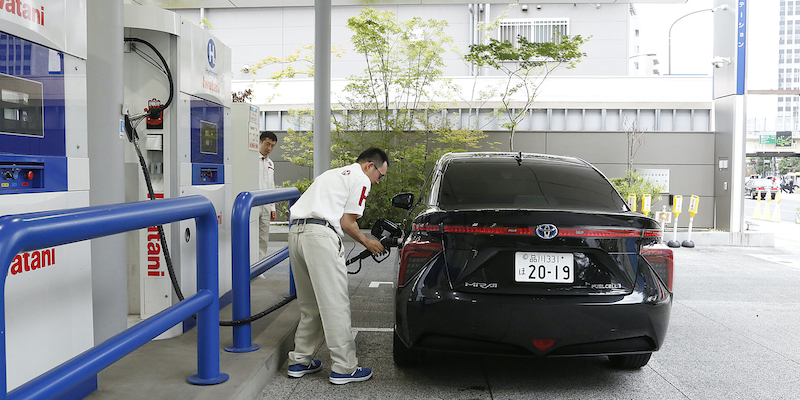For decades, researchers, experts and politicians have promised that hydrogen cars will soon become a clean and sustainable alternative to diesel and gasoline ones. In 2003, the European Hydrogen and Fuel Cell Technology Platform, an organization sponsored by the European Union, estimated that 5 million hydrogen cars would be in circulation in the world by 2020. George W. Bush, when he was president of the United States, said that hydrogen cars would be on par with gasoline cars by 2010. In 2004 Arnold Schwarzenegger, then governor of California, promised that by 2010 there would be in the US state “hydrogen highways“, Full of hydrogen dispensers, in fact.
So far, things have gone differently. According to the International Energy Agency (IEA), an organization dependent on the OECD, in 2018 in the world only 11,200 hydrogen cars were in circulation, compared to 5.1 million battery electric cars. In the last two years, even if there is no more recent data available on hydrogen, the gap has certainly increased: in 2019 alone, according to the IEA, they were sold 2.1 million electric cars, while sales of hydrogen cars remained flat.
In general, after decades in which it has been repeatedly said that the time for hydrogen cars was about to arrive, by now most car manufacturers seem to have given up producing fuel cell (i.e. hydrogen) vehicles to focus on electric. Today there are only three hydrogen-powered car models on the market in the world, all three Japanese: the Toyota Mirai, the Hyundai Nexo and the Honda Clarity. The three automakers, however, are more famous for their hybrid or electric models rather than hydrogen ones. Most of the other manufacturing companies, such as Mercedes, Ford and GM, have abandoned their hydrogen car building projects in recent years and turned to electric. Volkswagen has done the same, but still has plans to produce a hydrogen SUV through Audi in 2023. Hyundai a few months ago tried to relaunch its line of fuel cell cars with a commercial made together with the very famous band k-pop BTS, but for now there is no news of any great sales results.
In short, the project to fill the streets with hydrogen cars seems to have failed, at least for now. To understand the reason we need to understand how hydrogen is produced, to be used not only in cars but everywhere: in transport, in industrial and domestic environments. The main problems, in summary, are three: production, infrastructure and convenience.
Gray, blue and green
The first thing to know about hydrogen is that it is not found in its pure state in the environment, but in substances such as water, natural gas or oil. To obtain it, therefore, there are some more or less efficient and more or less harmful methods for the environment. The most common one is defined as a “vapor reforming reaction” and is a process whereby hydrogen (or rather, a synthesis gas with a high hydrogen content) is generated starting from hydrocarbons (often methane) and water vapor . As a result of the process several tons of CO are generated2; for each ton of hydrogen produced: therefore hydrogen is defined as “gray”. Gray hydrogen is also the cheapest to produce – around $ 1.5 per kilo.
Then there is the “blue” hydrogen, in which the production process is similar but CO2, instead of being released, it is “captured” and stored underground, to avoid dispersion into the atmosphere (approximately 90 percent of the CO2 is captured). Blue hydrogen is slightly more expensive to produce – it can be as high as $ 3.5 per kilo. Gray and blue hydrogen are by far the most used. In 2018, he wrote l’Economist, 95 percent of industrial hydrogen was produced from hydrocarbons.
Finally, there is “green” hydrogen, which is what interests us most because it is the only one that is truly zero-emission. Green hydrogen is created starting from a process of electrolysis (ie separation of hydrogen and oxygen) of water through a machine called an electrolyzer. This process needs electricity to work, and obviously, for the hydrogen produced to be truly “green”, this energy must be generated from renewable sources: both the electrolyser and renewable energy are quite expensive, and these so that green hydrogen costs between 4 and 8 dollars per kilo. However, things are improving: both the cost of electricity from renewable sources and that of electrolysers are dropping drastically, and the European Union, where it already costs a little less than in other areas, expects hydrogen by 2030 verde will cost 1.5 dollars per kilo: a fairly competitive price. There are also other types of zero-emission hydrogen, such as that generated with pyrolysis processes.
Investments
Hence, enormous investments are required to produce energy with hydrogen at considerable levels. A few days ago BloombergNEF did an analysis of the projects for the hydrogen economy contained in the European Green Deal, the European Commission’s ambitious plan to reduce net emissions to zero by 2050. The plan also includes two documents published in July, which speak of a continental strategy for large-scale production of green hydrogen and foresee gigantic investments, with the aim of bringing the power of the electrolysers to 500 Gigawatts (which is a lot, considering that the peak of electric power use recorded throughout Europe, he wrote BloombergNEF, was 546 Gigawatts). To do this, a very substantial investment is needed in electrolysers, in increasing the production of renewable energy and in the construction of infrastructures for the transport, storage and supply of hydrogen on the territory (we are talking about a complex of pipes spread throughout the continent, partly by converting gas pipelines): in all, the European Union has estimated it to be between 320 and 458 billion euros between now and 2030.
– Read also: The European Green Deal, well explained
Is it convenient?
We understood that to really get hydrogen into the energy mix we need to produce a lot of extra energy from renewable sources, invest in new infrastructures and convert part of the existing ones. Is all this work worth it? In some cases no: since electricity is needed to produce green hydrogen, the laws of thermodynamics tell us that the amount of energy generated by that hydrogen will always be less than the energy used to produce it. And therefore, in many situations, it is better to use renewable electricity directly and give up hydrogen.
This is the case with cars. Hydrogen vehicles are equipped with large tanks of pressurized gas which, by reacting with oxygen taken from the atmosphere, generates electricity. These vehicles, however, have no better characteristics than battery electric ones, quite the opposite: considering an electric car with a battery of comparable capacity, a hydrogen car does not have more autonomy, it is not lighter, it has less space in the trunk ( due to the cylinders), has less acceleration, less top speed and costs an average of 20 percent more. And, like a gasoline car, it has many moving parts, so it requires expensive maintenance (the very small amount of moving parts in an electric car means that in many models it is not even mandatory to have an annual service). Furthermore, hydrogen must be stored at high pressure and very low temperatures, and it is obviously very flammable, even if the cars that use it have sophisticated safety systems.
A hydrogen “concept car” presented by Toyota in 2014. (AP Photo / Julie Jacobson)
–
Above all, hydrogen cars are inefficient compared to battery electric ones: BloombergNEF he calculated that a family electric car needs 25 kWh of energy to travel 100 kilometers, including the loss of energy in the grid and the battery cycle; a hydrogen car needs 50 kWh of energy, considering the costs of electrolysis, compression, transport, storage and conversion of hydrogen. “To put it simply, hydrogen cars are half as efficient as battery electric cars, and there is no physical reason to think this will change,” he writes. BloombergNEF.
In other cases, however, hydrogen is worthwhile, because that generated by hydrogen can be a source of clean energy with some unique characteristics: in particular, it can be stored and stored practically anywhere, which is impossible with electricity generated by wind power. and photovoltaics, unless there is a major change in battery technology. Hopefully, hydrogen could become an important element of the global energy mix, albeit not for cars. According to the Hydrogen Council, a lobby group in Brussels, hydrogen could satisfy by 2050 18 percent of the world’s energy needs.
– Read also: Keep an eye on the batteries
For example, if hydrogen technology is not very convenient in cars, it can become so in trucks and lorries, because the autonomy of the batteries only reaches a certain point, and building too big is inconvenient. Nikola, an American startup much discussed recently, has promised to produce hydrogen trucks within a few years. Hydrogen has good prospects for use on ships and airplanes as well. For example, Airbus recently announced that by 2035 it will make three models of commercial hydrogen aircraft and zero emissions.
Experts also argue that hydrogen could be used cost-effectively to heat homes and offices. At least part of the same pipeline network used for natural gas can be used to distribute it: many countries, including Australia, Germany and the UK are considering the idea. The body that takes care of the British grid that brings gas to homes, National Grid, he said all’Economist that most homes in the UK could already now be heated with a mix of 20 per cent hydrogen, without modification. Furthermore, some producers are starting to sell boilers capable of burning not only natural gas but also pure hydrogen.
Furthermore, hydrogen storage capacities will be fundamental in a society that is increasingly electrifying. Today, electricity meets 20 percent of the world’s energy needs, but this percentage could double or quadruple in a few decades. The production of renewable electricity, however, is not constant (the solar panels only work well if there is the sun, the wind turbines only if there is wind) and it is difficult to store. For this reason, up to now, other sources of energy (mainly hydrocarbons) have been used to fill the gaps in supplies. In a future world with zero emissions, the role of energy-refuge when electricity from renewables for whatever reason is not available could be held by hydrogen, which can be stored practically indefinitely and practically everywhere.
–


